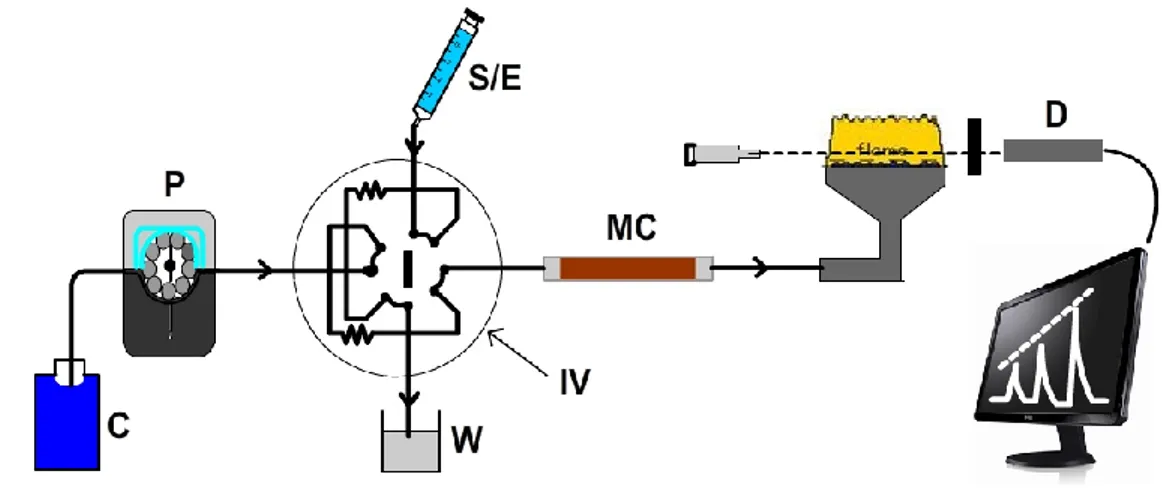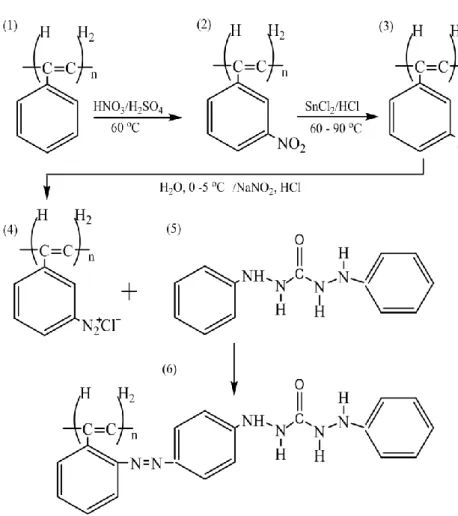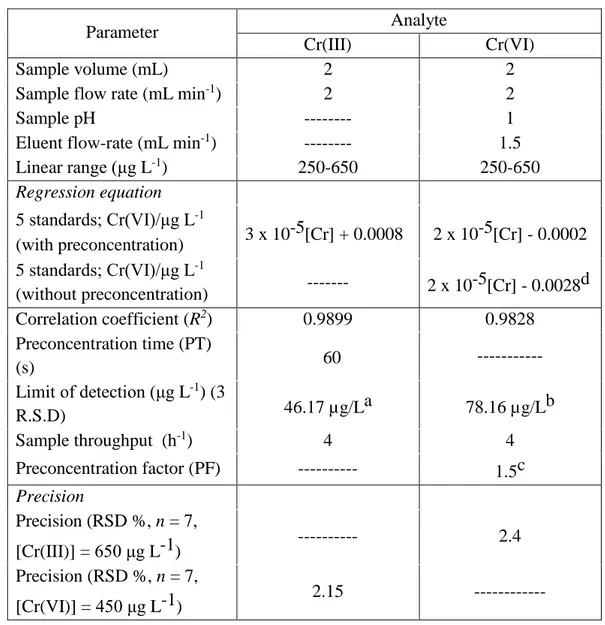SELECTIVE ON-LINE PRECONCENTRATION
AND ANALYSIS OF Cr(III) AND Cr(VI) BASED ON FLOW
INJECTION ANALYSIS USING A CHELATING RESIN
THESIS
Written work as one of the requirements to obtain a Masters degree from the Bandung Institute of Technology
By
RONALD KENNEDY TALVAT
NIM : 20513317
(Chemistry Masters Program)
BANDUNG INSTITUTE OF TECHNOLOGY
March, 2016
ABSTRACT
SELECTIVE ON-LINE PRECONCENTRATION
AND ANALYSIS OF Cr(III) AND Cr(VI) BASED ON FLOW
INJECTION ANALYSIS USING A CHELATING RESIN
By
Ronald Kennedy Talvat
20513317
A chelating polymeric matrix (chelating resin) was fabricated via functionalization of a polystrene-divinyl benzene co-polymer Amberlite XAD 16 resin matrix with a chelating organic ligand, 1,5- diphenylcarbazide (DPC) through a diazotization mechanistic route using the electrophilic aromatic substitution mechanism and was characterized by fourier transform infra-red spectroscopy (FT-IR). The chelating resin was used in the flow injection analysis (FIA) on-line solid phase extraction (SPE) coupled with flame atomic absorption spectrometry (FAAS). This simple developed method was based on the selective preconcentration of retained Cr(VI) by the XAD-16-DPC chelating resin packed in a minicolumn with no interference from unretained Cr(III). The conventional SPE procedure was divided into two steps: preconcentration procedure, and elution with detection procedure. Cr(VI) was strongly retained by the resin forming a complex at pH 1 using 0.05 M H2SO4
and was used as the carrier with an optimum adsorption equilibrium time of 60 min. Using 2.5 MH2SO4 as the eluent, Cr(VI) ions were quantitatively eluted into the
nebulizer burner system. The retention capacity of the resin using the batch method found was 8.55 mg Cr(VI) g/resin with a dynamic retention of 28.07 µg Cr(VI)/g resin using the column method under optimized conditions. The preconcentration factor (PF) obtained was 1.5 as an evaluation of the FIA performance. The precision expressed as coefficient of variance (CV) of Cr(VI) measurements was 2.15% at the 450 µg L-1 level with a detection limit of 47.17 µg L-1 and the CV of Cr(III) was 2.40% at the 650 µg L-1 level with a detection limit of 78.16 µg L-1. The linear calibration for both species was also established over the concentration range of 250-650 µg L-1 with Cr(III) and Cr(VI) correlation coefficients of 0.983 and 0.99,
respectively, along with a sampling frequency of 4 samples/hr at a sample flow- rate of 2 mL min-1. Cr(III) determination was also performed by simply measuring its concentration at the end of the column and after Cr(VI) retention by the chelating resin. Total chromium determination was carried out using the FAAS direct aspiration analytical method to verify the sum of Cr(III) and Cr(VI) concentrations. The developed method can be successfully applied to trace analysis of chromium
ii
species in environmental water samples on a µg L-1 level.
Keywords: Cr(VI), Cr(III), preconcentration, speciation, flow injetion analysis, chelating resin
iii
ABSTRAK
PRAKONSENTRASI DAN ANALISIS SLEKTIF Cr(III) DAN
Cr(VI) BERBASIS ANALISIS INJEKSI ALIR
MENGGUNAKAN RESIN PENGKELAT
Oleh
Ronald Kennedy Talvat
20513317
Pengkelat dengan matriks polimer (resin pengkelat) telah disintesis melalui fungsionalisasi resin polimer polystrene-divinyl benzene Amberlite XAD-16 dengan ligan pengkelat organik 1,5-divinilkarbazida (DPC) melalui mekanisme diazotisasi menggunakan mekanisme subtitusi elektofilik aromatik. Hasil reaksi telah dikarakterisasi dengan menggunakan FTIR dan digunakan pada metoda analisis injeksi alir (Flow Injection Analysis, FIA) sebagai kolom ekstraksi fase padat yang ditandemkan dengan spektrometer serapan atom (AAS). Metode yang dikembangkan ini didasarkan pada retensi prakonsentrasi penahan Cr(VI) terhadap Cr(III) oleh resin pengkelat XAD-16-DPC dalam suatu mini-kolom. Prosedur SPE yang konvensional dibagi menjadi dua tahap yaitu prakonsentrasi dan pegelusian dengan pendeteksian. Cr(VI) diretensi secara kuat oleh resin membentuk suatu kompleks pada pH 1 dengan menggunakan larutan H2SO4 0,05 M dan waktu
kesetimbangan adsorbsi 60 menit. Kondisi inilah yang digunakan sebagai kondisi optimum adsorbsi pada kolom. Penggunaan H2SO4 0,25 M sebagai larutan
pengelusi dapat mengelusi Cr(VI) ke sistem pembakar nebulizer. Kapasitas retensi resin terhadap Cr(VI) dengan metode batch sebesar 8,55 mg per gram resin dan kapasitas retensi dinamik dengan menggunakan kolom sebesar 28,07 µg per gram resin. Faktor prakonsentrasi yang didapatkan melalui evaluasi kinerja FIA adalah 1,5 kali. Presisi pengukuran yang dinyatakan dengan koefisien varian (CV) adalah sebesar 2,5% pada konsentrasi 450 µg L-1 dengan limit deteksi sebesar 47,17 µg L -1 untuk Cr(VI), sedangkan untuk Cr(III) sebesar 2,4% pada konsentrasi 650 µg/mL
dengan limit deteksi 78,16 µg L-1. Linieritas kurva kalibrasi untuk kedua spesi tersebut berada pada rentang 250-650 µg L-1 dengan koefisien korelasi untuk Cr(VI)
dan Cr(III) beturut-turut sebesar 0,983 dan 0,99. Frekuensi analisis contoh dapat diperoleh hingga 4 sampel/jam dengan kecepatan aliran sampel sebesar 2 mL/menit. Penentuan konsentrasi Cr(III) juga dilakukan dengan melakukan pengukuran pada ujung kolom setelah dilakukan peretensian Cr(VI) oleh resin pengkelat. Penentuan kromium total dilakukan dengan menggunakan FAAS
iv
dengan metode analisis aspirasi langsung untuk memverifikasi jumlah Cr(VI) dan Cr(III). Metode yang dikembangkan pada tingkat renik ini telah berhasil untuk menganalisis spesi kromium dalam sampel air pada tingkat konsentrasi µg L-1. Kata kunci : Cr(VI), Cr(III), prakonsentrasi, spesiasi, analisis injeksi alir, resin pengkelat.
27
Figure III-2 Flow injection analysis single manifold: C, carrier (0.05 M H2SO4);
P, pump; W, waste; IV, injection valve; S, sample (tap water); E, eluent (2.5 M H2SO4); MC, minicolumn (XAD-16-DPC chelating resin); D, detector (FAAS).
III.4.3.2.4.2 Performance of flow injection analysis Determination of the preconcentration factor
Preconcentration factor (PF), or often called the sensitivity of increase was calculated based on the ratio of slope of the calibration curves of Cr(VI) obtained with the online preconcentration to the slope without preconcentration. See determination of linearity. The preconcentration method proposed was applied to the determination of Cr(VI) only.
III.4.3.3 FAAS analytical method validation III.4.3.3.1 Determination of precision
The precision of this analytical method was evaluated by making repeated independent measurements on identical standard solutions of Cr(III) and Cr(VI) to determine the spread of results. Each solution of 450 µg L-1 Cr(VI) and 650 µg L
-1 Cr(III) were measured repeatedly with the same measurement conditions
35
Figure IV-10 Reaction synthesis pathways for XAD-16-DPC chelating resin.
IV.2 Characterization of XAD-16-DPC chelating resin
The chelating resin was characterized by FT-IR spectrophotomer using the KBr pellet method. For the PSDVB-NO2 compound, where the nitro group is attached
to an aromatic ring, the N–O stretching bands can be seen at wave numbers of 1346.31 cm-1 and 1523.76 cm-1. The N–O asymmetric stretch are usually found between wave numbers of 1550-1475 cm-1 and for N–O symmetric stretch are found between1360-1290 cm-1 as shown in Figure A-1. The absorption bands of the nitro
group usually shows sharp peaks on the infrared spectrum. There is also a correlation relationship between their percentage transmittance (% T) and wave number (cm-1). The absorption band of the nitro group was eliminated after the
49
IV.6.7 Analytical figures of merit
Table IV-4 Performance of the FI-SPE-FAAS on-line system for simultaneous
determination and analysis of Cr(III) and Cr(VI) under optimized conditions.
Parameter Analyte
Cr(III) Cr(VI)
Sample volume (mL) 2 2
Sample flow rate (mL min-1) 2 2
Sample pH --- 1
Eluent flow-rate (mL min-1) --- 1.5
Linear range (μg L-1) 250-650 250-650 Regression equation 5 standards; Cr(VI)/μg L-1 (with preconcentration) 3 x 10-5[Cr] + 0.0008 2 x 10-5[Cr] - 0.0002 5 standards; Cr(VI)/μg L-1 (without preconcentration) --- 2 x 10-5[Cr] - 0.0028d Correlation coefficient (R2) 0.9899 0.9828 Preconcentration time (PT) (s) 60 --- Limit of detection (μg L-1) (3 R.S.D) 46.17 µg/La 78.16 µg/Lb Sample throughput (h-1) 4 4 Preconcentration factor (PF) --- 1.5c Precision Precision (RSD %, n = 7, [Cr(III)] = 650 μg L-1) --- 2.4 Precision (RSD %, n = 7, [Cr(VI)] = 450 μg L-1) 2.15 ---
a Mean and S.D. of 7 determinations calculated at 450 μg L-1 Cr(VI), b Mean and S.D. of 7
determinations calculated at 550 μg L-1 Cr(III), c Calculated as the ratio of slope of the calibration
curve obtained with the online preconcentration to the slope without preconcentration,
d Calibration curve of unretained Cr(III) obtained by passing its standards solutions through the


